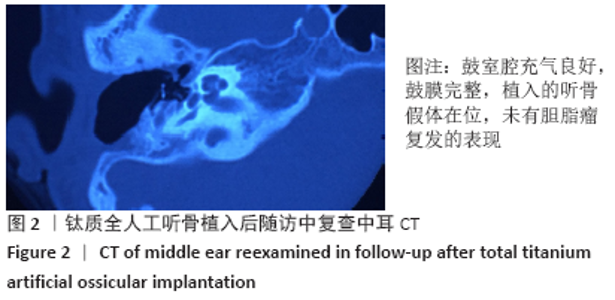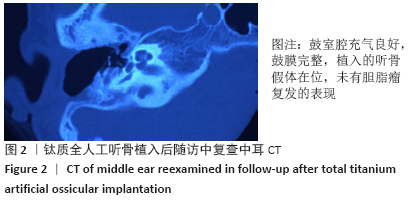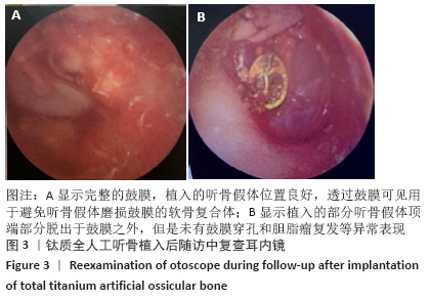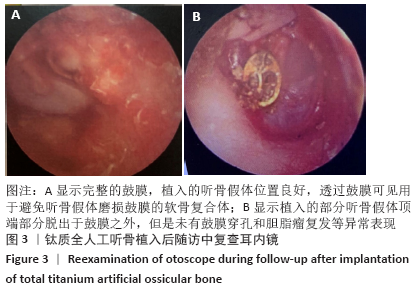[1] SUDHOFF H, TOS M. Pathogenesis of attic cholesteatoma: clinical and immunohistochemical support for combination of retraction theory and proliferation theory. Am J Otol. 2000;21(6):786-792.
[2] CASTLE JT. Cholesteatoma Pearls: Practical Points and Update. Head Neck Pathol. 2018;12(3):419-429.
[3] HIRAUMI H, KANEMARU SI, MIURA M, et al. Histopathological evaluation and long-term results of soft tissue preservation technique in cholesteatoma surgery. Eur Arch Otorhinolaryngol. 2017;274(2): 711-714.
[4] GAURANO JL, JOHARJY IA. Middle ear cholesteatoma: characteristic CT findings in 64 patients. Ann Saudi Med. 2004;24(6):442-447.
[5] MAJEED J, SUDARSHAN REDDY L. Role of CT Mastoids in the Diagnosis and Surgical Management of Chronic Inflammatory Ear Diseases. Indian J Otolaryngol Head Neck Surg. 2017;69(1):113-120.
[6] ROGHA M, HASHEMI SM, MOKHTARINEJAD F, et al. Comparison of Preoperative Temporal Bone CT with Intraoperative Findings in Patients with Cholesteatoma. Iran J Otorhinolaryngol. 2014;26(74):7-12.
[7] SANNA M, AGARWAL M, KHRAIS T, et al. Modified Bondy’S technique for epitympanic cholesteatoma. Laryngoscope. 2003;113(12): 2218-2221.
[8] GOYCOOLEA MV. Mastoid and tympanomastoid procedures in otitis media: classic mastoidectomy (simple, modified, and radical) and current adaptations; open-cavity, closed-cavity, and intact-bridge tympanomastoidectomy. Otolaryngol Clin North Am. 1999;32(3): 513-523.
[9] DE ZINIS LO, TONNI D, BAREZZANI MG. Single-stage canal wall-down tympanoplasty: long-term results and prognostic factors. Ann Otol Rhinol Laryngol. 2010;119(5):304-312.
[10] ASLAN FELEK S, ISLAM A, CELIK H, et al. The functional and anatomical results of the canal wall down tympanoplasty in extensive cholesteatoma. Acta Otolaryngol. 2009;129(12):1388-1394.
[11] LEE HJ, CHAO JR, YEON YK, et al. Canal reconstruction and mastoid obliteration using floating cartilages and musculoperiosteal flaps. Laryngoscope. 2017;127(5):1153-1160.
[12] HARUN A, CLARK J, SEMENOV YR, et al. The Role of Obliteration in the Achievement of a Dry Mastoid Bowl. Otol Neurotol. 2015;36(9): 1510-1517.
[13] VAN DINTHER JJS, COOPMAN R, VERCRUYSSE JP, et al. The Bony Obliteration Tympanoplasty in Pediatric Cholesteatoma: Long-term Hearing Results. Otol Neurotol. 2018;39(6):715-723.
[14] YAMAMOTO Y, TAKAHASHI K, MORITA Y, et al. Long-term follow-up results of canal wall down tympanoplasty with mastoid obliteration using the bone pate plate for canal wall reconstruction in cholesteatoma surgery. Otol Neurotol. 2014;35(6):961-965.
[15] TZELNICK S, YANIV D, RAVEH E, et al. Tympanomastoidectomy for Cholesteatoma in Children: Audiometric Results. Ann Otol Rhinol Laryngol. 2019;128(10):956-962.
[16] COX MD, TRINIDADE A, RUSSELL JS, et al. Long-Term Hearing Results After Ossiculoplasty. Otol Neurotol. 2017;38(4):510-515.
[17] ŞEVIK ELIÇORA S, ERDEM D, DINÇ AE, et al. The effects of surgery type and different ossiculoplasty materials on the hearing results in cholesteatoma surgery. Eur Arch Otorhinolaryngol. 2017;274(2): 773-780.
[18] FAYEZ BAHMAD JR, MERCHANT SN. Histopathology of Ossicular Grafts and Implants in Chronic Otitis Media. Ann Otol Rhinol Laryngol. 2007;116(3):181-191.
[19] BASSIOUNY M, BADOUR N, OMRAN A, et al. Histopathological and immunohistochemical characteristics of acquired cholesteatoma in children and adults. Egyptian Journal of Ear Nose Throat &Allied Sciences. 2012;13(1):7-12.
[20] OLSZEWSKA E, WAGNER M, BERNALSPREKELSEN M, et al. Etiopathogenesis of cholesteatoma. Eur Arch Otorhinolaryngol. 2004; 261(1):6-24.
[21] 陈龙云,魏兴梅,高志强,等.中耳胆脂瘤听小骨骨质侵犯研究[J].中华耳科学杂志,2019,17(4):510-513.
[22] Vartiainen E, Karjalainen S. Autologous ossicle and cortical bone in Ossicular reconstruction. Clin Oto1aryngol Allied Sci. 1985;10(6): 307-310.
[23] 杨名保,张艳红,赵海亮,等.自体听骨在听骨链重建中的应用及疗效观察[J].中华耳科学杂志,2015,13(4):688-692.
[24] SHINOHARA T, GYO K, SAIKI T, et al. Ossiculoplasty using hydroxyapatite prostheses: long-term results. Clin Otolaryngol Allied Sci. 2000;25(4): 287-292.
[25] Meijer AG, Segenhout HM, Albers FW, et al. Histopathology of biocompatible hydroxylapatite-polyethylene composite in ossiculoplasty. ORL J Otorhinolaryngol Relat Spec. 2002;64(3):173-179.
[26] KRUEGER WW, FEGHALI JG, SHELTON C, et al. Preliminary ossiculo-plasty results using the Kurz titanium prostheses. Otol Neurotol. 2002; 23(6):836-839.
[27] HAHN YB, BOJRAB DI. Outcomes following ossicular chain reconstruction with composite prostheses: hydroxyapatite-polyethylene vs. hydroxyapatite-titanium. Ear Nose Throat J. 2013;92(6):250-254.
[28] 余力生.中耳研究论文中常见的问题[J].中华耳鼻咽喉头颈外科杂志,2006,41(8):563-565.
[29] KHEMANI S, SINGH A, LINGAM RK, et al. Imaging of postoperative middle ear cholesteatoma. Clin Radiol. 2011;66(8):760-767. |



